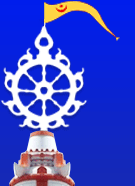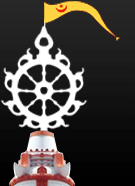SHREEMANDIRA >> Subsidiary Shrines
Lakshmi Temple
The shrine of Goddess Lakshmi lies in the north-western corner of the inner enclosure of the main temple. The temple structure is four fold. It has Viman or deul, Jagamohana, Natamandap and a Mukhasala. It appears that the Vimana and the Jagamohana were originally constructed and the other two were added later. The Vimana is a Rekha deula, pancharatha in plan facing east. It is believed that Lakshmi temple was built during the construction of Shree Jagannath Temple. In Madala Panji it is also claimed that king Anangabhima Deva built some 60 subsidiary shrines in Puri. As such, the construction of the present temple of Lakshmi or Mahalakshmi may be ascribed to him. But, some research scholars are of the opinion that the Mahalakshmi temple was built during Chodaganga Deva at the initiative of Ramanuja who visited Shreekshetra during 12th century.
Goddess Lakshmi, known as Mahalakshmi, is sitting on a lotus. Two elephants are pouring water on Her head from pitchers. In two out of her four hands, she is holding lotuses and her two other hands show the posture of ‘Abhaya’ and ‘Barada’ Mudra. Mahalakshmi is considered as the goddess of wealth. She is Shakti of Lord Narayana. Puri is named after her name as Shreekshetra.
The Mahalakshmi temple was protected through lime plaster. After deplastering of the lime cover various architectural carvings have been revealed.
In the Jagamohan, there is a beautiful image of Lakshmi – Nrusimha and at the pedestal there is a saint, who is normally identified as Shri Sankaracharya. But in the Natamandira there are paintings of the Ramanuja School. These paintings include the pictures of different Gods and Goddesses worshipped by the Ramanuja sect, pictures of Ganesh, Hanuman, Nrusimha, Varaha, Krushna with Radha are particularly attractive. The Natamandira is used for religious discourses, recitation of Stotra, Sthuti of Shree Mahalakshmi and Saharsanama of Vishnu etc.
There is a special kitchen for Mahalakshmi. Different varieties of sweet cakes are prepared daily in that kitchen and offered to Her by Pujapanda servitors.
Devotees usually sit for a while in the Natamandira of the said temple to receive the blessings of Goddess Mahalakshmi.
Goddess Vimala Temple
The shrine of Goddess Vimala is situated on the south- western corner of the Kurma Bedha (inner compound) facing the east. It is an the oldest temple established in the main temple premises. This temple has four sections i.e, Vimana (the main temple), Jagamohana (where people gather to see the goddess), Natamandira and a Mukhasala. According to Madala Panji, the temple of Vimala was constructed by Yajati Keshari. According to some foreign scholars, the original shrine of mother Vimala might have been established at a still earlier date by Bhoumakar Monarchs who were particularly prone to patronise the building of tantric cult edifices, both brahminical and buddhist. The image of Goddess Vimala bears some typical iconographic characteristics leading one to assign it to Bhouma at phase (Shakti cult in Orissa). Dr. H.K. Mahatab famous historian, has also observed in Orissa History that Goddess Vimala was worshipped in the present temple during 8th century A.D.
Goddess Vimala is commonly known as “Pada Pitheswari”. The image of the Goddess is said to have been built in Laksa (wax) and hence it has been described in “Utkala Itihasara Angyata Adhaya” by Chakradhar Mohapatra.
Maa Vimala occupies a very important position in Jagannath Temple. Vimala is standing on a lotus. She is four- armed and holds a Aksamala (rosary), a human figure, a Kalasa (jar) in three hands while the fourth hand is in ‘Varada’ posture.
The shrine of Vimala is believed to be suitable for Tantric from of worship. Vimala is stated to be the Bhairavi and Shree Jagannatha, the Bhairava. After each dhupa i.e Raj dhupa offering made to Shree Jagannatha, these are again offered to Vimala and there is no separate Bhoga offering for this Goddess.
Certain specific rituals are performed during Sharadiya Durga Puja festival in the temple of Vimala. These have special significance. The Ratha Samanta bramhins of Bir-Narasinghpur perform special puja of the Goddess during Sharadiya Durga Puja.
Goddess Vimala is the source of energy and strength. She protects her devotees from all kinds of dangers. She is worshipped by the priests in Maya Bija Mantra “Hrim”.
The devotees are allowed entry inside this temple upto Jagamohana from morning till late night i.e, till Pahuda rituals. During Sharadiya Durga Puja there are some special restrictions to allow the devotees inside the temple.
Surya Narayana Temple
The temple of Surya Narayana is situated in the northern side of the main temple and faces to the east. In this temple Sun God is seen sitting in a chariot drawn by seven horses. The idol was originally at Konark. When Konark temple was in ruins this image was brought by Raja Narasingha Dev of Bhoi dynasty (1612-1646 A.D) and was placed here for worship. A few more idols of Surya and his consorts are under worship in the temple. This temple also has a separate Kitchen.
Special puja is conducted in this temple on Sun day, on lunar and solar eclipses, Sambadasami and Magha Sukla Satpami.
A special feature of this temple is that marriage negotiations (Nirbandha) are done here. The parents of both the Bride and the Bridegroom take a vow before Sun God to get their children married to each other.
Nrusimha Temple
The temple of Nrusimha is situated towards the southern side of the main temple within its inner enclosure and this temple also faces to the east. The temple is a Pancharatha Rekha deula without a Jagamohana. It is one of the oldest temple adjacent to the famous Muktimandapa. The architectural style of the temple dates back to 10th century A.D.
The presiding deity of the temple is Lord Nrusimha and a very small image of the deity is placed inside the temple on a high seat. As many as sixty one stone inscriptions are found inscribed on the body of the temple at different places, but mostly on the door jambs. Some of these inscriptions refer to events occurring during the reign of Chodaganga Deva. Some research scholars have opined that the Nrusimha temple was considered to be the abode of Purusottama- Jagannatha before the present temple was constructed by Ananta Varma Chodaganga Daeva and that it can be assigned to the period of Somavansi dynasty in Utkala. Noted scholar late Dr. Satya Narayan Rajguru has opined that Purusottama Jagannatha was being worshipped here in the temple and after the construction of the present temple of Shree Jagannatha, the image was shifted to the main temple.
Devotees are allowed entry at the main entrance of the Vimana to have darshan of the deities from morning to night.
Satya Narayana Temple
In the east south corner of inner bedha (Kurma bedha), the temple of Satya Narayana is situated. Satya Narayana is an image of Lord Visnu. He is having four hands. He holds Sankha, Gada, Chakra and Padma in his four hands. The idol is constructed in black granite.
Devotees worship Satya Narayana on the occasion of the birthday of their children.
Bhubaneswari Temple
The temple of goddess Bhubaneswari stands in the western side of the main temple, facing the east. The Vimana is of Rekha order, while the Jagamohana is constituted of a few pidhas. The temple is also called Panchashakti temple.
The presiding deity of the temple is Bhubaneswari or Kamala. She is four handed with three eyes, she holds Pasa in one hand and Ankusa in another hand. In the other two hands Abhaya and Barada posture are exhibited.
In the Jagamohana an image of Saraswati is housed towards the southern side, while the image of Savitri, Gayatri and Sasthi are installed in another niche in the northern side. The parents worship Sasthi for the welfare and long life of their children.
Certain specific rituals are performed during Sharadiya Durga puja festival in the temple of Bhubaneswari.
Devotees are allowed to enter Bhubaneswari temple through its main entrance (east facing) for darshan of the deities. Generally the darshan is allowed from morning till late night i.e, the time of Pahuda ritual of the said deity.





